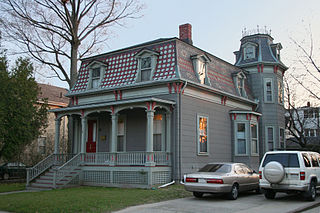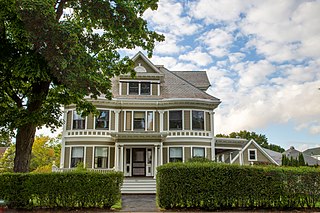
The Bayley House is a historic house at 16 Fairmont Avenue in Newtonville, Massachusetts, US. Built in 1883–84, it is a prominent example of Ruskinian Gothic architecture, designed by the noted firm of Peabody and Stearns. It was listed on the National Register of Historic Places in 1986.

The Peirce School is a historic school building at 88 Chestnut Street, corner of Austin Street, in West Newton, Massachusetts. The brick building was built in 1895 and operated by the Newton Public Schools as an elementary school from 1895 until June 1951. It originally served grades one through eight, but at the time of its closing, it was a kindergarten through sixth grade (K–6) school. It was listed on the National Register of Historic Places on December 6, 1979.

The Nathaniel Topliff Allen Homestead is a historic house at 35 Webster Street in the village of West Newton, in Newton, Massachusetts. The Greek Revival house is notable as the home of Nathaniel Topliff Allen (1823–1903), an innovative educator in the mid-19th century. Allen's pioneering work influenced the development of new teaching methods taught at the state normal school. The house is listed in the National Register of Historic Places, and is currently owned by Newton Cultural Alliance.

The Brackett House is an historic house located at 621 Centre Street in the Newton Centre village of Newton, Massachusetts. Built about 1844, it is a prominent local example of Greek Revival architecture, with a four-column temple front. Extensively damaged by fire in 2010, a careful restoration was completed in 2013. It was listed on the National Register of Historic Places on October 4, 1986.

The Henry Bigelow House is a historic house in the Newton Corner village of Newton, Massachusetts. Built about 1830, it is a good local example of Greek Revival architecture, important as home to Henry Bigelow, a prominent local educator and philanthropist. On September 4, 1986, it was added to the National Register of Historic Places.

The Samuel Farquhar House is an historic Second Empire style building located in the village of Newton Corner in Newton, Massachusetts. The 1+1⁄2-story wood-frame house was built c. 1868. Its mansard roof is shingled in slate tiles of varying colors and shapes, arranged in decorative patterns. It has well-preserved decorative porch woodwork, and an octagonal 2+1⁄2-story turret at one corner. The roof lines are lined with dentil moulding with paired brackets. It is one of the finest Second Empire houses in the city.

The Dr. Henry Jacob Bigelow House is a historic house at 72-80 Ober Road in the Oak Hill village of Newton, Massachusetts. Built in 1887, it is one of the last private residences designed by noted American architect Henry Hobson Richardson. It was converted into condominiums in the 1980s by the PBS program This Old House. It was listed on the National Register of Historic Places in 1976.

The Beth Eden Baptist Church is a historic Baptist church building at 84 Maple Street in Waltham, Massachusetts. Built in 1891, it is a fine local example of Romanesque Revival architecture and is further notable as the oldest church on Waltham's South Side. The church was added to the National Historic Register of Historic Places in 1989. Its Settled Pastor is Rev. Dr. Esther Pearson.

The First Parish Church is a historic church at 50 Church Street in Waltham, Massachusetts, whose Unitarian Universalist congregation has a history dating to c. 1696. The current meeting house was built in 1933 after a fire destroyed the previous building on the same site. It is a Classical Revival structure designed by the nationally known Boston firm of Allen & Collens. The church building was listed on the National Register of Historic Places in 1989.

Maple-Union Corners is a historic district centered at the intersection of Maple and Union Streets in Springfield, Massachusetts. The area is prominent as the location of the Springfield Female Seminary building, and for the distinctive homes of several of Springfield's prominent 19th century citizens. The house at 83 Maple Street, was first owned by Solomon Merrick, inventor of the monkey wrench, and was later owned by Ansel Phelps, the fourth mayor of Springfield. Townhouses at 76-78 and 80-84 Maple Street comprise the rest of the district; owners or occupants included Francis Fuller, owner of the Fuller Block, and Edmund Chapin, president of the John Hancock National Bank. The district was listed on the National Register of Historic Places in 1976.

The Padilla Beard House is a historic house at 18 Maple Street in Stoneham, Massachusetts. Built about 1850, it was listed on the National Register of Historic Places in 1984 for its association with Padilla Beard, the first operator the stagecoach line on the route between Boston and Reading. The house was listed on the National Register of Historic Places in 1984.

The C.H. Brown Cottage is a historic house at 34 Wright Street in Stoneham, Massachusetts. Probably built in the 1830s, it is a well-preserved example of worker housing built for employees of local shoe factories. It was listed on the National Register of Historic Places in 1984.

The Mayall Bruner House is a historic house at 36 Magnolia Avenue in the Newton Corner neighborhood of Newton, Massachusetts. Built in 1923, it is a well-preserved example of Craftsman architecture. It was listed on the National Register of Historic Places in 1990.

The John Buckingham House is a historic house at 33–35 Waban Street in the Newton Corner village of Newton, Massachusetts. Built about 1864, it is a good local example of Second Empire architecture, typical of built at that time for upper middle class commuters to Boston. It was listed on the National Register of Historic Places in 1986.

The Henry I. Harriman House is a historic French château style house at 825 Centre Street in Newton, Massachusetts. Built in 1916 for Henry I. Harriman, it is one of Newton's most elegant 20th-century suburban estate houses. It is now part of the campus of the Boston College Law School. It was known as Putnam House, in honor of benefactor Roger Lowell Putnam, when the campus was that of Newton College of the Sacred Heart. It was listed on the National Register of Historic Places in 1990.

The House at 511 Watertown Street in Newton, Massachusetts is one of the city's finer Colonial Revival houses completed in 1897. The house was listed on the National Register of Historic Places in 1986 and is on the border of two of Newton's older villages: Newtonville and Nonantum.

House at 60 William Street is a historic house at 19 Jefferson Street in the Newton Corner village of Newton, Massachusetts. It is listed at 60 William Street in Massachusetts cultural inventory and National Register listings. Built in 1850, it is a well-preserved example of a modest Italianate wood-frame house. It is a 2+1⁄2-story wood-frame building, with an L-shaped layout that has a three-story tower at the crook of the L. Italianate styling includes the tower's shallow-pitch hip roof, and paired round-arch windows on its top level.

The Thayer House is a historic house at 17 Channing Street in Newton, Massachusetts, USA. It was listed on the National Register of Historic Places in 1986.

The S. D. Newton House is a historic house at 8 Sycamore Street in Worcester, Massachusetts. Built in 1846, it is an excellent local instance of Greek Revival styling, and one of the few houses surviving from that period in the neighborhood. which once had many more of such houses. The house was listed on the National Register of Historic Places on March 5, 1980. Unfortunately the current keeper of the home has let it go. Not much original left. Garbage everywhere on the inside. Lead paint, peeling paint. An eyesore it has become. It once was a great piece of local history.

The Charles Maynard House is a historic house at 459 Crafts Street in Newton, Massachusetts. The house was built in 1897, and is a fine local example of a Queen Anne Victorian with some Colonial Revival styling. It is also notable as the home of naturalist and taxidermist Charles Johnson Maynard. The house was listed on the National Register of Historic Places in 1996.























